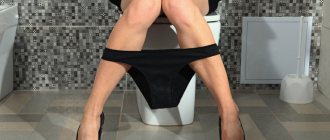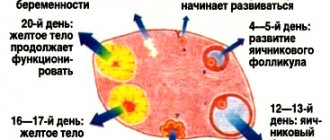Is it worth performing a “vacuum” on critical days?
The essence of the exercise is that after maximum exhalation, the chest is straightened with the stomach due to the intercostal muscles, thereby simulating inhalation. In this case, the stomach “sticks” to the spine and remains in this position for some time, comfortable for the person performing the exercise. Among the advantages of this exercise is the ability to perform it at any time, anywhere: at home, at work, in transport, sitting, standing, lying down, resting on your hands.
The benefits of a vacuum, in addition to improving your figure, are that:
- Visceral fat burns more actively;
- Digestion improves, constipation is eliminated;
- metabolism accelerates;
- venous outflow from the lower extremities improves;
- respiratory muscles are trained;
- microcirculation improves.
Despite its simplicity and accessibility, a vacuum state in the abdominal cavity is contraindicated in some situations. Among them:
- peptic ulcer of the stomach and duodenum;
- diseases of the cardiovascular system;
- surgeries on the abdominal cavity and pelvic organs (6 months);
- hiatal hernia;
- increased intracranial pressure;
- lung diseases;
- thrombosis;
- acute inflammatory or exacerbation of chronic diseases.
A special question arises when performing the exercise on critical days.
Any clear categorical answer will not be correct. The menstrual cycle of a healthy woman is variable, just as weight gain these days occurs differently for each person. Normally, the duration of menstruation ranges from 2-3 to 5-7 days. They occur in 21 - 35 days. In a healthy woman, menstruation is practically painless; minor nagging pain may be observed before or on the first day of menstruation. Normal blood loss is between 50-150 ml.
If a healthy woman’s well-being is not affected during her period and she does not want to interrupt her training, there is no reason to prohibit the vacuum. You need to focus on the sensations after completing the exercise. If the exercise is not accompanied by pain or increased bleeding, it is not necessary to interrupt training. If any discomfort, pain or increased bleeding occurs, you should avoid performing a vacuum on these days.
It is more correct, after deciding to engage in yoga practices, to undergo a consultation with a gynecologist to identify gynecological pathologies and consult with a yoga therapist, since the answer to the question of whether it is possible to do a vacuum during menstruation is individual.
Many gynecologists believe that against the background of training, irregular menstruation is restored, PMS and painful periods stop. This is due to improved blood supply to organs that are part of the menstrual cycle regulation system and normalization of hormonal balance. However, it is better for such patients to refrain from using a vacuum during their critical days.
Technique for performing abdominal vacuum exercises for men and women
In pursuit of a flat stomach, many people work hard on their abdominal muscles, but they see the opposite result - their stomach only gets bigger. This happens because the rectus abdominis and oblique muscles grow under stress. But the “vacuum” exercise strengthens the transverse abdominal muscle; with its help, many people have managed to remove a few extra centimeters from the waist.
Photos before and after
to contents ^
Benefit
The exercise came from yoga to fitness and bodybuilding thanks to Arnold Schwarzenegger. With its help, many athletes were able to create a beautiful silhouette. But yoga is not aimed at the relief and beauty of the body, but at the harmonious development of the whole organism, including health.
Therefore, if we talk about the benefits of a vacuum, we touch on topics related not only to a flat stomach. In fact, exercise affects the body in the following way:
- Strengthens the transverse muscles, the main role of which is to support internal organs and reduce the volume of the abdomen, thereby creating a beautiful silhouette and thin waist.
- Promotes the burning of visceral fat - the most dangerous fat in the body, thereby improving the condition of internal organs.
- When performing the exercise, the intestinal walls are activated. His motor skills and digestion process improve, which helps in getting rid of problems with stool.
- Exercise improves blood circulation in the abdominal area, and this has a beneficial effect on the functioning of the gastrointestinal tract.
- Improvement of the condition of the back in the lumbar region, which results in improved posture, as well as prevention of the formation of hernias in this area.
- The descended organs of the abdominal region return to their rightful places.
- Regular exercise will improve metabolic processes in the body, which will facilitate weight loss, if necessary, and get rid of waste and toxins.
- In order for the exercise technique to be correct, you need to follow the breathing recommendations, and this will help enrich the entire body with oxygen.
- Exercise has a beneficial effect on the nervous system.
- No additional inventory or special equipment is required for implementation.
- The exercise can be done in various positions, as well as in any convenient place.
to contents ^
Peculiarities
The key to success when performing any exercise is the correct technique. To learn how to properly do a stomach vacuum, beginners need to take into account certain implementation features:
- You need to carefully study all the recommendations and strictly follow the description of the exercise.
- The first time you need to perform the exercise standing in front of a mirror to monitor whether all conditions are met.
- This is more of a breathing exercise than a physical one. Therefore, it is important to monitor your breathing.
- Correct execution of a vacuum does not consist in tensing the abs to the point of trembling, but, on the contrary, in relaxing all the abdominal muscles and stretching them due to the difference in pressure in the abdominal cavity and the diaphragm.
- The main thing is regularity, only then will the vacuum be effective.
- If you feel any discomfort, you should stop doing the exercise.
- At first it will be difficult to hold your breath; you need to start with a few seconds, but then gradually increase the time.
- The best time to do it is in the morning on an empty stomach. Be sure to do some exercise during this time. During the day, perform when your stomach is not full of food.
- The most effective way to complete your abdominal workout is with a vacuum exercise. Vacuum is muscle stretching, not pumping. And at the end of the workout, the abdominal muscles are just warmed up and can easily be stretched.
The number of repetitions and approaches is not strictly limited. Typically performed 7-10 times per approach. How many times to do a stomach vacuum depends on your preparation and desire, but it is advisable to do at least 2-3 approaches a day.
to contents ^
Vacuum technique
The exercise can be performed from 4 starting positions: lying, sitting, standing and on all fours. The essence itself remains approximately the same, but the load levels are slightly different.
to contents ^
Lying down
This option is considered the easiest. When lying down, gravity acts on the abdominal organs, which helps to perform the exercise.
- Lie on your back, bend your knees, and extend your arms along your body.
- Exhale freely, release all the air from your lungs.
- The most difficult thing is the “cheating” breath. It is necessary to inhale, drawing in the stomach, but the air should not enter the lungs.
- Imagine that your goal is to touch your stomach to your spine.
- Stay in this position. The time depends on the level of preparation.
- If you feel a sharp lack of oxygen, take a small breath.
- Exhale and relax your stomach.
to contents ^
Sitting
This option is considered more difficult and should be performed only when the previous technique has been mastered. The difficulty lies in the fact that the muscles that keep the body level are not relaxed at the time of the exercise.
- Sit on a chair or any comfortable surface.
- Bend your knees at an angle of 90 degrees and keep your back straight. Do not lean against anything or lean back.
- Place your hands on your knees.
- Exhale through your mouth.
- Take a “false” breath, drawing in your stomach.
- Relax and catch your breath.
to contents ^
standing
- Place your feet shoulder-width apart.
- Bend your legs slightly, place your hands on your hips.
- Lower your head slightly, but look up. In this position, air will not flow to the lungs.
- Exhale, then draw in your stomach.
- If you feel the organs rise to the ribs, you are doing everything right.
- Relax.
Once you have mastered the standing technique, you can make the exercise more difficult. Lean your body forward 45 degrees, keeping your knees slightly bent and your hands resting on your legs but not resting on them. This option is often used by professional athletes.
to contents ^
On the knees
Gravity also plays a part here. You will have to cope with its resistance; it pulls the organs towards the floor, so this version of the exercise is considered the most difficult.
- Get on all fours.
- Your wrists, elbows and shoulders should form a line perpendicular to the floor.
- The knees are under the pelvis and bent at a right angle.
- Exhale and take a “false” breath.
- Pull your stomach in.
- Tilt your head forward slightly. The back is slightly arched.
- Draw in your stomach, exhaling first.
- Relax by inhaling air and regaining your breathing.
The vacuum will help both women and men get a flat stomach and a thin waist. Perform the exercise regularly, and during the day, still draw in your stomach, so the state of tension will become familiar to the muscles, they will always be in good shape, and you will reach your goal faster.
to contents ^
Harm and contraindications
Negative consequences can only occur if you ignore the recommendations and rules for performing the exercise.
But some contraindications still exist:
- You should not perform the exercise during menstruation or a week before it begins, as muscle tension can cause the onset or intensification of bleeding.
- It is strictly forbidden to make a vacuum in the abdomen during pregnancy. This can cause premature birth or miscarriage. Women who have recently given birth should consult a doctor if they want to practice this technique.
- Diseases of the gastrointestinal tract force you to exercise with extreme caution. But ulcers are those factors that a vacuum completely excludes from training.
- If you have diseases of the cardiovascular system, blood circulation is impaired, this is another reason to refrain from doing the exercise.
- Absence of menstruation (amenorrhea) and the presence of any neoplasms in the pelvic organs.
- Lung diseases.
- Exacerbation of chronic diseases or inflammatory processes;
- Problems with bowel movements.
If you liked our article and have something to add, share your thoughts. It is very important for us to know your opinion!
woman-l.ru
Why can't you do a vacuum during menstruation?
If there is the slightest deviation in the menstrual cycle, a vacuum during menstruation is not recommended. In order not to cause harm to the female body, vacuum is prohibited in the following cases:
- hyperpolymenorrhea;
- acyclic uterine bleeding;
- adenomyosis;
- ovarian cysts and cystomas;
- uterine fibroids;
- tubo-ovarian inflammatory formations;
- oncological diseases;
- uterine polyps and hyperplastic processes in the endometrium;
- pregnancy at any stage;
- postpartum period the first month and a half.
The main danger of exercise on critical days is that increased blood supply to the abdominal and pelvic organs provokes increased spotting or bleeding. The reason is precisely this (increased organ perfusion), and not that abdominal tension is transmitted to the muscles of the uterus. Moreover, the classic vacuum is not accompanied by tension in the abdominal muscles. If there is an inflammatory process, it may spread.
Opinion of gynecologists
Adamov Vladimir Ivanovich, obstetrician-gynecologist, Omsk Patients who care about their figure often ask me whether it is possible to do a stomach vacuum or other abdominal exercises during menstruation. I always answer such questions in the negative, because tension in the abdominal wall increases uterine bleeding, which is undesirable. Rakova Anna Konstantinovna, gynecologist, Izhevsk I believe that it is possible to perform a vacuum during menstruation, but only on the 5th day of the menstrual cycle. If you start doing exercises earlier, there is a risk of increasing the amount of discharge, and there is also a risk of negative consequences. I have been approached more than once by girls with amenorrhea who abused physical activity during menstruation.
Possible negative consequences
Among people who study yoga practices, there is an opinion that yoga is not a healing technique; it is intended exclusively for healthy, physically strong people. The vacuum does not cause tension in the abdominal muscles, but creates negative pressure in the abdominal cavity, and the organs are pulled upward. This effect may be temporary, and as a result the person receives permanent prolapse of the internal organs.
On topic: Super effective abdominal exercises
Getting interested in any practice should begin with consultation with a specialist. The principle “Do no harm!” is also relevant in this case.
Source
The benefits and harms of vacuum exercises for a woman’s body
Most women constantly monitor their appearance: they want to be slim, fit and beautiful. A lot of different physical activities are used for this. They can be done at any age, with any physical fitness. To determine whether it is possible to do a abdominal vacuum during menstruation, it is necessary to consider the positive and negative aspects of this complex.
The main benefits are as follows:
- Effective for weight loss.
- The waist size decreases, in contrast to the use of standard tasks, where the abdominal muscles are pumped up.
- Visceral fat, which envelops the internal organs, is burned. Thanks to this, the body begins to function better.
- The digestive process improves.
- Metabolism accelerates.
- A person trains proper breathing, thanks to which the entire body is saturated with oxygen.
- Posture is corrected.
- Vigor and strength come.
The technique is not without possible harm to the body. It is not suitable for abdominal training in case of gastrointestinal diseases, heart problems, heavy menstruation and pregnancy. If you have a stomach ulcer, the technique is contraindicated.
You can learn more about stress during menstruation from the video
Abdominal vacuum - how to do it correctly and how many times
Hello again! Paradoxically, when it comes to building a beautiful body, the most difficult thing to achieve is a flat stomach. And everyone naturally thinks that for this they need to download it. During constant training of the abdominal muscles, adipose tissue is replaced by muscle tissue, but it is not always possible to get rid of the bulging, which is visually not very beautiful. And a vacuum in the abdomen can achieve a perfectly flat press – today we will look at how to do this amazing exercise correctly.
What does a stomach vacuum give?
The vacuum exercise was used back in the classical times of bodybuilders, borrowing it from yoga. For example, the legendary Schwarzenegger had a thin waist thanks to vacuum.
What you can achieve by doing this exercise:
- Without pumping your abdominal muscles, you will have a flat stomach with a thin waist.
- The folds in the lower abdomen will disappear.
- Your posture will be straightened.
- The fat that accumulates around the internal organs will disappear.
- You will protect your lower back from various diseases.
Reviews from both amateurs and professionals indicate that the waist decreases by 1-3 centimeters.
How does this happen? Classic abdominal exercises work mainly on the rectus abdominis muscle (upper and lower abs). The vacuum uses the transverse muscle, located under the rectus and oblique muscles. In other words, it is a kind of belt that narrows our waist.
Read: exercises for a thin waist that can be performed both in the gym and at home.
Performing the vacuum exercise correctly
Before you start working on your abs, you should know that the best time to do this is in the morning before breakfast, that is, on an empty stomach. Drinking water before classes is also not recommended. This exercise does not require any special warm-up - it can be done even immediately after waking up, while still lying in bed.
There are several vacuum options:
- in a lying position;
- On knees;
- sitting on a chair;
- standing on a hard surface.
Accordingly, the first one is considered the easiest, and the last one is considered the most difficult. Let's look at the detailed technique for performing each option.
Lying down
Lie on your back with your arms extended along your body and your knees bent. Having relaxed, exhale all the air from yourself, draw your stomach in, as close to your back as possible, holding for a while. For beginners, 15 seconds is enough, gradually increasing the load to a minute.
On knees
Stand on 4 points (hands and knees), then you need to do everything in the same sequence as the previous time. But move on to this exercise after you have mastered the vacuum while lying down, being able to hold it for 60 seconds or more.
Sitting
In a sitting position, the muscles that hold the body in space in an upright position are activated, which is more difficult. Sit on a chair without leaning your back on the surface - while exhaling deeply, pull your stomach in as much as possible and sit like that for at least a minute.
standing
You need to perform the vacuum while standing in exactly the same way as in the previous position. Once you reach this level of difficulty, try to bring the total time you hold the position for the entire workout to 5 minutes.
Watch the video with recommendations:
Is it worth performing a “vacuum” on critical days?
The essence of the exercise is that after maximum exhalation, the chest is straightened with the stomach due to the intercostal muscles, thereby simulating inhalation. In this case, the stomach “sticks” to the spine and remains in this position for some time, comfortable for the person performing the exercise. Among the advantages of this exercise is the ability to perform it at any time, anywhere: at home, at work, in transport, sitting, standing, lying down, resting on your hands.
The benefits of a vacuum, in addition to improving your figure, are that:
- Visceral fat burns more actively;
- Digestion improves, constipation is eliminated;
- metabolism accelerates;
- venous outflow from the lower extremities improves;
- respiratory muscles are trained;
- microcirculation improves.
Despite its simplicity and accessibility, a vacuum state in the abdominal cavity is contraindicated in some situations. Among them:
- peptic ulcer of the stomach and duodenum;
- diseases of the cardiovascular system;
- surgeries on the abdominal cavity and pelvic organs (6 months);
- hiatal hernia;
- increased intracranial pressure;
- lung diseases;
- thrombosis;
- acute inflammatory or exacerbation of chronic diseases.
A special question arises when performing the exercise on critical days.
Any clear categorical answer will not be correct. The menstrual cycle of a healthy woman is variable, just as weight gain these days occurs differently for each person. Normally, the duration of menstruation ranges from 2-3 to 5-7 days. They occur in 21 - 35 days. In a healthy woman, menstruation is practically painless; minor nagging pain may be observed before or on the first day of menstruation. Normal blood loss is between 50-150 ml.
If a healthy woman’s well-being is not affected during her period and she does not want to interrupt her training, there is no reason to prohibit the vacuum. You need to focus on the sensations after completing the exercise. If the exercise is not accompanied by pain or increased bleeding, it is not necessary to interrupt training. If any discomfort, pain or increased bleeding occurs, you should avoid performing a vacuum on these days.
On topic: Pump up abs like Tyson
It is more correct, after deciding to engage in yoga practices, to undergo a consultation with a gynecologist to identify gynecological pathologies and consult with a yoga therapist, since the answer to the question of whether it is possible to do a vacuum during menstruation is individual.
Many gynecologists believe that against the background of training, irregular menstruation is restored, PMS and painful periods stop. This is due to improved blood supply to organs that are part of the menstrual cycle regulation system and normalization of hormonal balance. However, it is better for such patients to refrain from using a vacuum during their critical days.
Execution options
You should always start standing or lying down, and then you will move on to other variations of the exercise. Why change position? Under the influence of gravity, the organs tend downward, and working out from different poses allows you to massage them qualitatively. So, let’s figure out how to do vacuum abdominal exercises at home:
In a supine position
Vacuum lying down is one of the simplest options, accessible even to beginners. Lie on the floor, bend your knees so that your feet are firmly on the floor. Your hands either lie on the floor or are placed on your stomach so that you can feel the retraction. As you exhale, pull your stomach towards your spine so that it sticks. Hold it and try not to breathe for 10-15 seconds. Repeat the exercise 10 times. But don’t torture your body, and if you don’t have enough air, breathe. It will get better over time.
Standing
Also a good method, suitable for beginners. You can do it with a chair. Lean against a chair and bend over slightly. As you exhale, draw in your stomach. The back will most likely be slightly rounded, this is normal. Once you have mastered the chair technique, learn to do the exercise while standing upright and then raising your arms up to engage your upper abdominal muscles. Start with 10 repetitions, and then do 15 or 20, increasing the number of approaches.
On the knees
Sit on your knees, put your hands on them. Try to keep your back straight, your body should be slightly tilted forward. Inhale and pull your stomach towards your spine.
You can modify this exercise by performing it on all fours, this is a relatively difficult option, since you also have to fight gravity, which will require more effort than in other options.
In a sitting position
Having learned how to perform a vacuum while sitting, you can train anywhere: at home at the computer, at work, on public transport. This kind of physical education does not attract attention, but is very effective. Your back should be straight and your chin should be lowered towards your chest, otherwise you may experience a cough. If you want to make it more difficult, use a fitball or fitness ball instead of a chair.
Why can't you do a vacuum during menstruation?
If there is the slightest deviation in the menstrual cycle, a vacuum during menstruation is not recommended. In order not to cause harm to the female body, vacuum is prohibited in the following cases:
- hyperpolymenorrhea;
- acyclic uterine bleeding;
- adenomyosis;
- ovarian cysts and cystomas;
- uterine fibroids;
- tubo-ovarian inflammatory formations;
- oncological diseases;
- uterine polyps and hyperplastic processes in the endometrium;
- pregnancy at any stage;
- postpartum period the first month and a half.
The main danger of exercise on critical days is that increased blood supply to the abdominal and pelvic organs provokes increased spotting or bleeding. The reason is precisely this (increased organ perfusion), and not that abdominal tension is transmitted to the muscles of the uterus. Moreover, the classic vacuum is not accompanied by tension in the abdominal muscles. If there is an inflammatory process, it may spread.
Is it possible to do a vacuum during menstruation?
Not only pregnancy, but also menstruation is considered a strong contraindication for doing abdominal exercises. When it occurs, it is important for a woman to forget about any other physical activity on the abdominal wall. Abdominal exercises not only give a lot of tension, but also change the abundance and nature of the discharge, which is fraught with consequences.
Important! The technique is also contraindicated for various inflammatory processes of the genital organs.
Gynecologists recommend refraining from performing the weight loss complex during menstruation. They insist that the girl wait a little - already on the 5-6th day of the cycle she is allowed to start her favorite exercises to eliminate an unsightly belly.
Nutrition for endometriosis
Diet will not cure endometriosis, but it will help alleviate symptoms and slow the progression of the disease. It is recommended to adhere to the following rules:
- Meals should be frequent, fractional - in small portions 5-6 times a day. Do not overload the digestive tract;
- From the diet you need to exclude foods that increase the production of estrogen: legumes, nuts and seeds (including flax seeds), white cabbage, mushrooms, seafood. It is necessary to limit the consumption of vegetable oil, dairy products, some fruits (peaches, apricots);
- Alcohol is prohibited, especially beer - it is rich in phytoestrogens. Sometimes you can afford good wine;
- It is not recommended to drink coffee - it increases estrogen production and changes tissue sensitivity. Many women note that frequent drinking of coffee increases pain during menstruation and on other days of the cycle. Don’t get carried away with strong tea and cocoa;
- It is worth adding foods that suppress the production of prostaglandins to your diet. If prostaglandin synthesis is reduced, pain decreases. This is primarily fish, fresh vegetables and fruits, and grain crops.
With endometriosis, a woman’s menu must include fresh vegetables and fruits, excluding those foods that increase the production of estrogen.
The goal of nutrition for endometriosis is to eliminate estrogen-producing foods and prevent weight gain. But you shouldn’t get carried away with strict diets. It is better to seek help from a nutritionist. The doctor will select an appropriate diet and help cope with the symptoms of the disease.
How is a stomach vacuum useful?
With the help of uddiyana bandha, internal organs are massaged, better blood supply occurs, and the body is renewed.
With regular training, the abs acquire a beautiful shape, a person is no longer bothered by constipation, and sleep improves.
Vacuum abdominal retraction can be done as an independent exercise, in addition to the main training for various muscle groups.
You might also be interested in learning about the plank exercise. A properly performed plank stance helps strengthen muscles, improve and stabilize posture, and as a result, eliminate back problems.
How to do the vacuum exercise correctly?
Vacuum technique:
- We take the starting position: put our feet shoulder-width apart, hands on our hips;
- We fill our lungs with air as much as possible. We inhale through the nose. Exhaling, we strive to bring the anterior abdominal wall closer to the back;
- We perform for about 20 seconds, then inhale and bring the stomach to the starting position.
To enhance the effect of the exercise, you should pay attention to the following points:
- For beginners, it is better to do the workout standing or lying down;
- During the exercise, you can use breathing according to the bodyflex program: powerful exhalation, rapid inhalation through the nose, exhale again through the mouth;
- When exhaling through the mouth, we free the lungs from oxygen;
- We help ourselves by taking a series of breaths through the nose;
- We visualize our navel and spine, strive to connect them;
- We do the retraction while exhaling;
- When inhaling, do not lower your stomach sharply down, perform the action at a slow pace and not all the way;
- Muscle contractions must last at least 15 seconds;
- You can perform uddiyana bandha both in the morning, before the first meal, and before bed;
- During the lesson, perform 2-3 approaches, repeat up to 15 times, the isometric contraction time is from 15 seconds.
On topic: How couples pump up their abs
Vacuum is the best exercise for the abdomen
What is a belly vacuum and how to perform it?
Useful properties of exercise. What muscles does abdominal vacuum train, and why can’t everyone do it? Read the answers to these questions in this article. Excess weight around the waist is a problem that even non-obese people face. Intense workouts burn calories, eliminating fat deposits over a long period of time. But the vacuums exercise shapes your waist much faster with minimal physical exertion, without requiring long sessions in the gym with weights or grueling cardio.
Properties
The Abdominal Vacuum exercise provides a beneficial effect on the body:
- increases the power of transverse abdominal muscle fibers;
- eliminates abdominal sagging;
- removes sagging internal organs;
- reduces back pain; narrows the waist;
- reduces the volume of visceral fat deposits concentrated around organs.
The workout is suitable for people who are not overweight, but have an elongated stomach. To perform the exercise we do not need additional sports equipment.
Vacuuming the abdomen takes minimal time and helps you learn to control your abdominal muscle fibers. During the exercise, the internal organs are massaged and work better.
The exercise visually makes the chest wider, which is why it is popular among bodybuilders.
The results of the abdominal vacuum can be seen after two weeks: the abs take on a toned shape and the abdominal muscles become stronger. With constant performance of the exercise, the load on the spinal column is reduced and the posture is straightened. For this reason, abdominal training is relevant for professional athletes, ordinary people, and women after childbirth.
What muscles are trained?
Vacuum is an exercise that comprehensively involves the muscles of the torso. The main load during training is placed on the large straight transverse and lumbar muscles. They are located under the straight and oblique muscle fibers of the abdomen. Responsible for controlling the depth of breathing during strength training. Training these muscles helps improve your performance in the squat and bench press.
The described groups of muscle fibers are rarely pumped and lag behind even in athletes. However, with their help, the explosive strength necessary to improve physical performance is developed.
Abdominal vacuum exercise is intended for training:
- Torso. More precisely, the following muscle groups are involved:
- The abdomen is straight, external, as well as internal oblique.
- buttocks – medium, small, and adductor.
- Back – extensors.
- The loin is square.
- Blades. List of muscles involved:
- anterior serratus (Musculus serratus anterior);
- diamond-shaped: large and small;
- lower trapezius (Musculus trapezius).
- Shoulders The following muscle groups are pumped: 1 – pectoralis major, 2 – deltoids, 3 – rotators.
- Hand. The triceps are being pumped.
The rectus muscles form the relief of the abdomen, and the transverse muscles prevent its protrusion. The vacuum helps to work them out, increasing the visibility of the cubes. If you do not load the transverse muscle, including special exercises in the training complex, this can provoke a gradual increase in abdominal volume, despite constant strength training.
Learning to do the exercise correctly
Even experienced athletes do not always know how to make a vacuum. The effectiveness depends on the duration of repetition. The optimal time for one isometric squeeze is one to two minutes.
The abdominal vacuum exercise can be done in three ways:
- Lying down. In the initial position, the legs are bent at the knees, the arms are placed along the body or spread to the sides. We relax and exhale slowly until there is no air left. The abdominal muscles are drawn in to maximum depth, and breathing is held. After 20 seconds, take a leisurely breath. Then repeat - breathing stops again for the same time. At the end of the repetition, the lungs are gradually filled with oxygen, and the body relaxes. The back remains level throughout the entire workout.
- Sitting. The palms rest on the knees, and the legs are placed at a 90-degree angle. Exhale slowly, after which the tension is held for 30 seconds. After this time, a gradual inhalation is performed. The exercise is repeated 3 times. Attention: if you feel dizzy, the duration of holding your breath is reduced.
- Standing. This position offers two options: with a straight stance and a tilted body forward. The second method is used by bodybuilders. The starting position is assumed and oxygen is slowly exhaled through the mouth. After the lungs are empty, the stomach gradually retracts to the limit. The described position is maintained for 30-60 seconds, and then inhales.
The listed variations have a common execution technique.
The load depends on the version. In a lying position, a person makes the least effort, so this option is recommended for beginners.
Intrinsic muscle groups are slow twitch fibers. They can easily bear the load. Working through them requires daily practice. Abdominal vacuum exercise allows you to reduce your waist circumference by five to ten centimeters.
It can be combined with other exercises when training the abs, drawing in the stomach as much as possible at the moment of twisting.
Performance increases with a gradual increase in load (duration of one repetition) from 20 to 60 seconds, adding 20 seconds every week.
Adviсe
Incorrect technique reduces the effectiveness of training. Even after reading the information on how to do the abdominal vacuum exercise, you can still make a number of mistakes. To prevent possible problems and improve results, you must adhere to the following tips:
- monitor the position of the spine and do not round your back;
- draw in your stomach slowly, controlling every movement;
- straighten your chest and bring your shoulder blades together;
- if you have no experience, perform repetitions lying down or sitting;
- air is exhaled through the mouth;
- the stomach should be pulled under the ribs;
- hold the vacuum for 10 seconds or more;
- perform on an empty stomach (after waking up or before going to bed).
In order to speed up muscle development and obtain results, it is allowed to perform a vacuum up to two times a day. The minimum repetition rate for one workout is five times. As you gain endurance, the number of inhalations and exhalations gradually increases.
When not to do the exercise
The vacuum exercise for the press involves a number of contraindications, in which case you should avoid it. Negative consequences during or after training can be caused by the following reasons:
- gastrointestinal diseases;
- menstruation;
- pregnancy;
- undergoing childbirth or surgery several months before physical activity;
- arterial hypertension, tachycardia, high blood pressure;
- cardiovascular diseases;
- lung diseases;
- abdominal hernia;
- weak abdominal muscles;
- diseases of internal organs located near the diaphragmatic septum.
In a normal state, performing the exercise does not cause pain or discomfort. Most often, abdominal vacuum is safe, but it will not bring significant benefits in the absence of a balanced diet and a competent training program.
Source: https://zen.yandex.ru/media/fiteria/vakuum—luchshee-uprajnenie-dlia-jivota-5dd13a12cd7152643c8dea6f
Cavitation during menstruation
This technique is also actively used during pregnancy, avoiding the period of the first trimester. Some experts consider pregnancy to be a contraindication for ozone therapy, even in the 2-3 trimesters. However, the benefits of ozone therapy during pregnancy are undeniable:
- ozone is an excellent alternative to drug treatment and immunostimulating drugs;
- Ozone therapy is a preventive measure against the threat of miscarriage and reduces the likelihood of weak labor;
- Ozone treatment helps to cope with gestosis.
It is strongly not recommended to do ozone therapy during menstruation, since there is a high probability of heavy bleeding. During menstruation, ozone treatment procedures should be postponed for several days.
Paykova Elena Vadimovna, cosmetologist at the Beauty Clinic
“With ozone therapy during pregnancy, some side effects may occur: renal colic, diuretic effect, slight increase in body temperature, increase in liver enzymes in the blood.
In this case, the course of treatment must be adjusted.”
m. Prospekt Mira 1 minute walk from the metro
m. Novoslobodskaya 1 minute walk from the metro
The procedure during menstruation is undesirable.
First of all, blood circulation increases, which can affect the following:
- duration of menstruation;
- increased blood loss;
- the appearance of pain.
It happens that clients refuse to interrupt the course of procedures due to the onset of menstruation and fear that the effectiveness of the sessions will decrease. However, these fears are unnecessary, since the procedure can be postponed for a period of 1 to 4 weeks, without the risk of a decrease in effectiveness. The cavitation process continues in the body even during breaks between procedures.
In order for the result to be long-lasting, the following rules should be followed:
- maintain a drinking regime (drink at least 2 liters of water daily);
- perform physical exercises;
- do self-massage of the problem area;
- refrain from drinking alcohol for three weeks after completing the course;
- use appropriate cosmetic procedures.
By adhering to these recommendations, the effect of the procedure will be more pronounced and will last for a long time.
Contraindications to abdominal vacuum
The practice of abdominal vacuum affects the functioning of the internal organs of the body, which, in addition to benefits for healthy people, can negatively affect health if a person has problems with the kidneys and digestive organs, the functioning of the cardiovascular system, or in the presence of ulcers.
Women during pregnancy will have to avoid the vacuum exercise until delivery.
Is it possible to do a vacuum during menstruation? Before the start of your critical days, the practice of this exercise, like other physical activities, should be suspended.
Work and rest with endometriosis
When choosing a profession, it is worth considering some restrictions:
- Heavy physical work, heavy lifting, etc. are not recommended;
- Do not work in a hot or too cold room;
High temperatures in the workplace can aggravate the disease.
- If you have a shift schedule, if possible, you should not work during menstruation.
It is better to relax with endometriosis in a temperate climate. Vacations in hot countries will not be beneficial - overheating is dangerous. But if you only like a beach holiday and want to go to the sea, you need to be careful:
- Do not stay in direct sunlight for a long time;
- Do not sunbathe on the beach during peak solar activity - from 11 a.m. to 4 p.m.;
- Choose comfortable, lightweight clothes in light colors made from natural fabrics (linen, cotton) - in them the skin breathes and the body does not overheat;
- Plan rest in the first half of the cycle - after the end of menstruation.
There is no categorical ban on tanning, but it is better not to risk it.
Many experts believe that endometriosis is a disease of active business women. Serious workload, constant stress, frequent business trips - all this leads to hormonal imbalance and immunological disorders. If you are diagnosed with endometriosis, you should choose a quieter job - without stress and overexertion.









